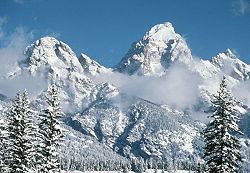Easiest route Climb, class 5.4. Prominence 1,990 m | Elevation 4,199 m First ascent 1898 | |
 | ||
Listing North America highest peaks 78thUS highest major peaks 60thUS most prominent peaks 46thUS most isolated peaks 95th First ascenders William Owen, Franklin Spencer Spalding, John Shive, Frank Peterson Similar Mount Moran, Middle Teton, Teewinot Mountain, Mount Owen, South Teton | ||
Visit grand teton national park national park in wyoming united states
Grand Teton is the highest mountain in Grand Teton National Park, in Northwest Wyoming, and a classic destination in American mountaineering.
Contents
- Visit grand teton national park national park in wyoming united states
- Map of Grand Teton Wyoming 83414 USA
- Grand teton national park wyoming usa in 4k ultra hd
- GeographyEdit
- NameEdit
- First ascentEdit
- First Ski Snowboard DescentsEdit
- Climbing routesEdit
- Ski descentEdit
- References
Map of Grand Teton, Wyoming 83414, USA
Grand teton national park wyoming usa in 4k ultra hd
GeographyEdit
Grand Teton, at 13,775 feet (4,199 m), is the highest point of the Teton Range, and the second highest peak in the U.S. state of Wyoming after Gannett Peak. The mountain is entirely within the Snake River drainage basin, which it feeds by several local creeks and glaciers. The Teton Range is a subrange of the Rocky Mountains, which extend from southern Alaska to northern New Mexico.
NameEdit
Grand Teton's name was first recorded as Mount Hayden by the Washburn-Langford-Doane Expedition of 1870. However, the name "the Grand Teton" had early currency. The Edition of April, 1901 of the USGS 1:125,000 quadrangle map of the area shows "Grand Teton" as the name of the peak. A United States National Park named "Grand Teton National Park" was established by law in 1929. By 1931, the name Grand Teton Peak was in such common usage that it was recognized by the USGS Board on Geographic Names. Another shift in usage led the Board to shorten the name on maps to Grand Teton in 1970.
The origin of the name is disputed. The most common explanation is that "Grand Teton" means "large teat" in French, named by either French-Canadian or Iroquois members of an expedition led by Donald McKenzie of the North West Company. However, other historians disagree, and claim that the mountain was named after the Teton Sioux tribe of Native Americans.
First ascentEdit
There is a disagreement over who first climbed Grand Teton. Nathaniel P. Langford and James Stevenson claimed to have reached the summit on July 29, 1872. However, some believe their description and sketches match the summit of The Enclosure, a side peak of Grand Teton. The Enclosure is named after a man-made palisade of rocks on its summit, probably constructed by Native Americans. Mountaineer and author Fred Beckey believes that the two climbed the Enclosure because their description matches it, because their description does not accurately describe the true summit, because their account does not mention the formidable difficulties found just above the Upper Saddle, and finally, because it was traditional with members of the Hayden Geological Survey of 1871 to build a cairn in such a place, but no such cairn was found when William O. Owen reached the summit in 1898. In all likelihood, The Enclosure was first climbed by Native Americans as suggested by Langford in 1873. Supporters of Owen included The Wyoming Legislature and Paul Petzoldt, former pioneer American climber. Ironically among Langford's supporters was Franklin Spalding, who led the ascent to the summit and tossed the rope that allowed Owen and the others to follow.
Mountaineer and author Leigh Ortenburger researched the controversy in depth, using original source material, for his 1965 climber's guidebook. Ortenburger concluded: "Since historical 'proof' is extremely unlikely to be forthcoming for either side of the argument, perhaps the best way of regarding the problem, short of a detailed analysis of the probabilities, is to state that in 1872 Langford and Stevenson may have climbed the Grand Teton, in 1893 Kieffer, Newell, and Rhyan may have climbed it, and in 1898 Spalding, Owen, Peterson, and Shive definitely did succeed in reaching the summit."
First Ski / Snowboard DescentsEdit
Climbing routesEdit
Grand Teton can be climbed via the Owen-Spalding route (II, 5.4). A short section of the route is highly exposed and previous alpine climbing experience is recommended before attempting an ascent; nonetheless, athletes with no prior climbing experience regularly reach the summit. The Owen-Spalding route is named for the climbers who claim to have made the first ascent: William Owen, Franklin Spalding, Frank Peterson, and John Shive. There is some debate as to which group made the first ascent; see that discussion. Notwithstanding the first-ascent controversy, this climbing route has been firmly named after William Owen and Franklin Spalding. The Owen-Spalding route begins at the Lower Saddle which is reached by walking from the Lupine Meadows Trailhead to Garnet Canyon and then up to the Lower Saddle on a trail that's fairly well defined. The more technical & exposed part of the climb begins at the Upper Saddle.
Ski descentEdit
The Grand Teton has been skied by five routes, each requiring at least one rappel. The first descent on skis was made by Bill Briggs in the spring of 1971 down the East Face and Stettner Couloir, it has since been renamed the Briggs Route. This descent required a free rappel, which was completed with skis on. More casually, skiing is possible from the crest of the saddle between the Grand and the Middle Teton, continuously into the valley floor.
